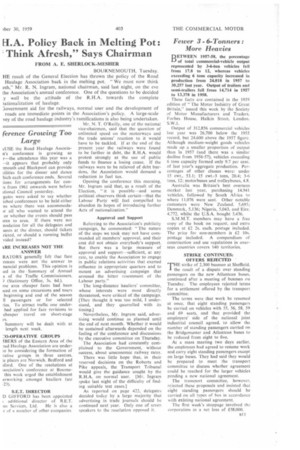Fewer 36-Tonners : More Heavies
Page 45

If you've noticed an error in this article please click here to report it so we can fix it.
BETWEEN 1957-58, the percentage of total commercial-vehicle output represented by 3-6-ton vehicles fell from 17.8 to 12, whereas vehicles exceeding 6 tons capacity increased hi production from 24,018 in 1957 to 30,257 last year. Output of trailers and semi-trailers fell from 14,714 in 1957 to 13,378 in 1958.
These facts are contained in the 1959 edition of "The Motor Industry of Great Britain," issued this week by the Society of Motor Manufacturers and Traders. Forbes House, Halkin Street, London. S.W.1.
Output of 312,856 commercial vehicles last year was 26,700 below the 1955 record, but 24.600 above the 1957 figure. Although medium-weight goods vehicles made up a smaller proportion of output than In 1957 (and there was a similar decline from 1956-57), vehicles exceeding 6 tons capacity formed only 9.7 per cent. of last year's aggregate production. Percentages of other classes were: under 15 cwt., 53.1; 15 cwt.-3 tons. 20.4; 3-6 tons, 12; motorbuses and trolleybuses, 4.8.
vehicles, followed by South Africa where 11,076 were sent. Other notable customers were New Zealand. 5,695; Denmark, 5,136; Nigeria, 5,043, and Fire. 4,772. whilst the U.S.A. bought 3,436.
S.M.M.T. members may have a free copy of the book on request, and extra copies at £2 2s. each, postage included. The price for non-members is £2 10s. postage included. A compendium of construction and use regulations in overseas countries covers 140 territories.
STRIKE CONTINUES: OFFERS REJECTED
THE strike of 2,300 busmen at Sheffield, the result of a dispute over standing passengers on the new Atlantean buses, continued after a meeting of busmen on Tuesday. The employees rejected terms for a settlement offered by the transport committee.
The terms were that work be resumed at once, that eight standing passengers be carried on vehicles with 55. 56, 58, 59 and 69 seats, and that provided the employers' side of the national joint industrial council agreed. to allow the number of standing passengers carried on the Bridgemaster and Atlantean buses to be reduced from eight to five.
At a mass meeting two days earlier, the employees had agreed to resume work and carry eight standing passengers except on large buses. They had said they would be prepared to meet the transport committee to discuss whether agreement could be reached for the larger vehicles pending a new national agreement.
The transport committee, however, rejected these proposals and insisted that eight standing passengers should be carried on all types of bus in accordance with existing national agreement.
The first week's stoppage involved the corporation in a net loss of £38,000.




















































































































